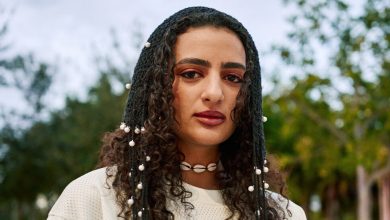The Holidays Are for Martinelli’s

Picture the ideal holiday spread: There are rich foods, festive place settings, twinkling candles. Maybe it includes multiple gravy boats and not one but two sweet potato side dishes. You might find a collection of celebratory beverages, wine and beer of various types, but there is one staple that is nonnegotiable for many households: a bottle of crisp, sparkling Martinelli’s cider.
Most hosts will tell you it’s for the kid’s table. But it’s also, decidedly, for the dads.
More of an apple juice guy than a beer dude, the Martinelli’s dad — an American archetype, I’d like to posit — embraces tradition and simple luxuries. He (though the Martinelli’s dad need not be a “he” or even a “dad”) loves the crinkle of foil and the dark green of the glass. He likes to swing by the grocery store to pick up a bottle before a party.
And he is part of a distinct cohort that is responsible for the brand’s skyrocketing sales this time of year. According to the company, 70 to 75 percent of 25.4-ounce Martinelli’s sparkling cider bottles sold each year are purchased between Halloween and New Year’s Eve.
For this particular consumer, if it comes down to Veuve Clicquot or Martinelli’s, there’s no contest. Pass the kid champagne, please.
That the sparkling cider is nonalcoholic is a tradition that dates back to Prohibition. The Martinelli family, immigrants from Switzerland, had been making hard cider in Watsonville, Calif., since 1868, but when the sale of alcohol became illegal in 1920, S. Martinelli & Company had to shelve that product. In addition to selling apple juice starting in 1917, the family made money by bottling Coca-Cola at their plant. On the side, they also began making single-serve sparkling juice, said John Martinelli, the chairman of the company, in a recent interview.
Mr. Martinelli, a fourth-generation leader of the business, recently ceded his role as chief executive to Gun Ruder, who introduced himself as the “first nonfamily member to run the family business.” (Still, by most definitions, he is family; Mr. Martinelli’s wife is Mr. Ruder’s sister.)
Both Mr. Martinelli, 64, and Mr. Ruder, 51, are real Martinelli’s dads, with plenty of stories of keeping their families and friends well stocked in “bubble juice,” as Mr. Martinelli’s kids called the sparkling cider when they were little.
Even after stepping down as chief executive, Mr. Martinelli continues to taste every day’s production of apple juice and cider so that he can pick up any flavor variations.
“That’s one of those things that is kind of a family tradition that was passed down,” he said, brightly, adding, “I do believe I have a very perceptive palate, especially as it relates to apple juice and apple juice flavors.”
In the late 1950s, about the time Mr. Martinelli was born, his father and grandfather decided to kick up production of their sparkling juice and market it as a “delightfully nonalcoholic” alternative to champagne.
Sales-wise, the beverage had a bit of a slow start. “But what happened was people started serving it to their kids,” Mr. Martinelli said. “It was a way the children could be festive with their families.”
Today, Martinelli’s sparkling cider comes in eight flavors and three sizes (the 25.4-ounce bottle, which the company refers to as its “iconic champagne bottle product,” usually retails for $3 to $6). There is Classic Apple Cider, Blush, Apple-Grape, Apple-Cranberry, and in more limited distribution, Apple-Pomegranate, Apple-Peach, Apple-Mango and Pear Cider. There are also organic editions.
In recent years, the company has considered ways to get “beyond the juice aisle,” Mr. Ruder said. In particular, “the whole ‘sober curious’ movement has caught our attention.”
“There used to be a stigma, to be quite honest, to the nonalcoholic beverage,” Mr. Ruder said. But now that people are drinking “nonalcoholic on some nights and alcohol on others, there’s a real opportunity for us to be part of that,” he said.
The company, Mr. Ruder said, has no intention of wading into any waters that stray from the vision of a “premium fruit forward product.” (Lest anyone think the company is opposed to alcohol, Martinelli’s recently released a limited run of hard cider, inspired by the family’s pre-Prohibition offerings.)
But one area where the company is ready to embrace change is in its marketing. In 2019, the brand tried out a modest Twitter campaign, using the hashtag #nexttimemartinellis, to encourage consumers to take a night off from alcohol. It didn’t get much traction.
Truthfully, Mr. Ruder said, “we’ve learned a lot from TikTok.”
Last year, the Martinelli’s dads at the helm of the brand were surprised by a viral moment on TikTok after some young people in Fresno, Calif., discovered that the sound of biting into the plastic of the Martinelli’s single-serve apple juice bottle mimicked the sound of biting into an actual apple. (The crunchy auditory effect was not intentional by the company, Mr. Martinelli said.)
Celebrities including Lizzo and David Dobrik posted their own videos trying it out, and the hashtags #Martinelli and #AppleJuiceChallenge received hundreds of millions of views.
Both dads initially heard about the trend from their daughters.
Mr. Ruder’s youngest daughters are 18 and 20. “They were the first people who brought this to my attention,” he said. “And I said, ‘Well jeez just give me some bullet points.’” One of them sent him “two or three pages of data,” he recalled.
Mr. Martinelli worried that the attention might be a bad thing — that perhaps teenagers biting into Martinelli’s plastic bottles would lead them to bite into their glass bottles next. He recalled asking his daughters: “How do I interpret this? Is it a good thing? Do I respond?”
Don’t respond, his daughters advised, emphatically. Just let it happen.
The Martinelli’s dads were further surprised by TikTok’s ability to lift sales. “It didn’t just sell another bottle of juice,” Mr. Ruder said. “It sold another 40 million bottles of juice in that category.” The viral trend also translated into sales of other Martinelli’s items, including its best seller, premium sparkling cider.
Perhaps a new generation of Martinelli’s dads is in the making?





